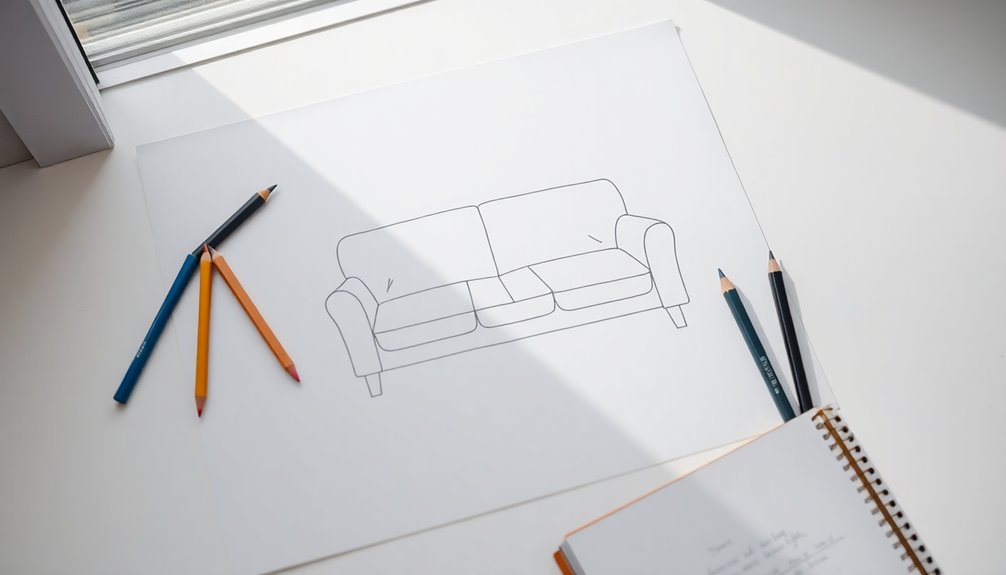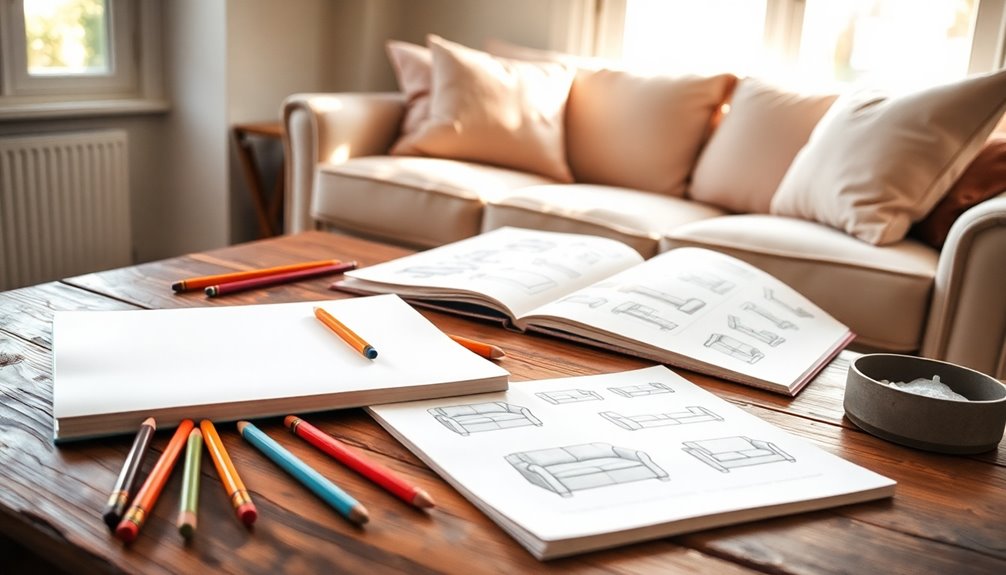Drawing a sofa is a fun way to boost your creativity and fine-tune your drawing skills. Start by sketching a large rectangle for the main body and adding smaller rectangles for armrests. Don't forget to include rounded cushions that fit well. Pay attention to proportions; legs should be smaller rectangles about a quarter the height of the seat. Details matter—add seams and buttons to give texture. Use reference photos to capture the right shapes and styles. Keep practicing, and you'll soon develop your unique touch. Stick around for more tips on enhancing your sofa drawing skills!
Key Takeaways
- Start by sketching a large rectangle for the main body of the sofa, establishing the foundation.
- Add two smaller rectangles at each end for the armrests, ensuring they are proportional.
- Use rounded shapes for cushions that fit within the sofa's outline, maintaining symmetry.
- Draw simple rectangles for the legs, about one-fourth the height of the seat for balance.
- Incorporate details like seams, buttons, and a throw blanket for added texture and coziness.
Importance of Drawing Skills

Drawing skills play an essential role in your development and well-being. They enhance your fine motor skills, improving hand-eye coordination and dexterity.
As you engage in drawing, you tap into your creativity and express yourself visually, allowing your ideas to come to life. Regular practice sharpens your cognitive abilities, like problem-solving and critical thinking, as you learn to observe and analyze what you see.
Furthermore, drawing builds your confidence and self-esteem; you can witness your progress and take pride in your creations.
Finally, it serves as a therapeutic outlet, helping to reduce stress and promote emotional well-being. Embracing drawing not only enriches your artistic journey but also contributes to your overall personal growth. Additionally, drawing can be an effective tool for personal development strategies, enabling you to explore transformative practices that enhance your skills.
Essential Drawing Materials

Creating a comfortable and inviting sofa sketch starts with the right materials. You only need basic items like a pencil and paper to get started, making this an accessible project for beginners.
An eraser can be handy for correcting any mistakes, while colored pencils can bring your drawing to life with vibrant hues. Make certain to set up a clear workspace; it'll help you focus and release your creativity.
You don't need any specialized or advanced tools, so this activity is perfect for children and novice artists alike. Finally, gather all your materials before you begin. This guarantees a smooth, uninterrupted drawing experience, letting your artistic vision flow freely.
Now, you're ready to plunge into sketching!
Basic Shapes for the Sofa

With your materials ready, you can start sketching the basic shapes that form the foundation of your sofa.
Begin by drawing a large rectangle for the main body; this will be the core of your drawing. Next, add two smaller rectangles on each end of the large rectangle to create the armrests.
Then, sketch a horizontal line across the top of the large rectangle for the backrest. To enhance your design, draw additional rectangles inside the main body to represent the cushions.
As you work, make certain that all shapes are proportionate and symmetrical. This balance will help create a pleasing appearance for your sofa design, making it look inviting and comfortable right from the start.
Adding Details to Your Drawing

Details bring your sofa drawing to life, making it more inviting and realistic. Start by sketching rounded cushions that fit proportionately to the sofa's outline. For the legs, draw simple shapes like rectangles or ovals at the bottom corners, guaranteeing symmetry for balance. Add seams and buttons to the cushions for a textured look. You can also drape a throw blanket over one side for a cozy feel. Finally, use colored pencils to shade your sofa, selecting colors that complement each other.
| Detail | Description | Purpose |
|---|---|---|
| Cushions | Rounded edges | Creates softness |
| Legs | Rectangles or ovals | Guarantees stability and symmetry |
| Seams/Buttons | Textured lines and dots | Adds realism |
| Throw Blanket | Draped fabric | Enhances coziness |
Techniques for Proportions

To make your sofa drawing look inviting and well-proportioned, start by establishing a solid foundation. Begin with a rectangular base for the seat, ensuring its width is about twice its height.
Next, divide the backrest into thirds, making each section slightly wider than the seat. For the cushions, use circles or ovals, keeping their size consistent with the base.
When drawing the legs, represent them as smaller rectangles, around one-fourth the height of the seat for proportion. To achieve symmetry, regularly measure and compare dimensions on both sides of the sofa, adjusting as needed.
This careful attention to proportion will help create a balanced and visually appealing sofa in your drawing.
Finalizing Your Artwork

Once you've sketched your sofa, it's time to enhance your artwork by refining the lines and adding depth. Start by going over your initial light sketches with darker lines for clarity. Next, erase any unnecessary guidelines or mistakes for a polished look.
Consider these steps to finalize your drawing:
- Review proportions and symmetry: Guarantee your sofa looks balanced and visually appealing.
- Add color: Use colored pencils to bring your sofa to life, adding a personal touch.
- Step back and evaluate: Take a moment to assess your artwork, making any last-minute adjustments to improve overall composition.
These actions will elevate your drawing and help capture the essence of your creative vision.
Tips to Enhance Your Skills

To enhance your drawing skills, make regular practice a part of your routine, even if it's just a few minutes each day.
Don't be afraid to explore different sofa styles to ignite your creativity and find what resonates with you.
Personalizing your designs with unique patterns and colors won't only make your artwork stand out but also reflect your individual flair. Additionally, incorporating mindfulness practices into your drawing sessions can help improve focus and creativity.
Regular Practice Sessions
Regular practice sessions are essential for honing your drawing skills, and setting aside dedicated time each week can greatly boost your progress.
Here are three tips to enhance your practice:
- Warm-Up Exercises: Begin each session by sketching basic shapes. This loosens up your hand and prepares your mind for more detailed work.
- Use Reference Images: Study real sofas to grasp proportions and intricate details. This will improve your accuracy and understanding of design.
- Maintain a Progress Journal: Regularly review past drawings, note your improvements, and set specific goals for your next practice session. This reflection keeps you motivated and focused on your growth as an artist.
With consistent practice, you'll see your skills flourish!
Explore Different Styles
As you build your drawing skills through practice, exploring different sofa styles can elevate your artistry even further.
Experiment with modern, traditional, or sectional designs to discover your personal preferences and broaden your skill set. Observing real-life sofas in various settings will inspire you to incorporate unique shapes, textures, and colors into your drawings.
Don't shy away from adding elements like armrests, cushions, and patterns; they can bring character and depth to your designs. Challenge yourself by recreating sofas from magazines or online sources to sharpen your ability to capture different perspectives.
Regularly sketching sofas in diverse styles enhances not just your drawing skills but also your understanding of proportion and design aesthetics.
Happy drawing!
Personalize Your Designs
Personalizing your sofa designs can transform your sketches from simple representations to unique expressions of your style.
To make your designs stand out, consider these tips:
- Experiment with fabrics and colors: Use vibrant hues and textures, like soft velvet or bold patterns, to create a striking look.
- Incorporate various styles: Mix modern, vintage, and sectional designs to diversify your portfolio and ignite your creativity.
- Add decorative elements: Enhance your sofa with throw pillows, cozy blankets, or intricate patterns to make it visually appealing.
Take inspiration from real-life sofas to understand proportions, and don't shy away from critiquing your work.
Feedback from others can help you grow as an artist and elevate your designs further.
Finding Inspiration in Real Life

While exploring your home or local furniture stores, you can find a wealth of inspiration for drawing sofas. Take a moment to observe different styles; notice the unique shapes and designs that stand out. When you find a sofa that catches your eye, snap a photo to use as a reference later.
Pay attention to the colors and textures of the fabrics, as these elements can spark your creativity. Practice sketching sofas from various angles to improve your ability to capture their proportions and details accurately.
Additionally, engage with online communities or social media platforms focused on interior design. You'll discover unique sofa styles and ideas that can further enhance your drawing skills.
Sharing Your Artwork With Others

How can sharing your artwork transform your drawing experience?
Sharing your drawings opens doors to valuable feedback, boosts your confidence, and connects you with other artists.
By showcasing your work, you not only receive constructive criticism but also inspire others.
Consider these three ways to share effectively:
- Social Media Platforms: Post your sketches and finished pieces to reach a wider audience and engage with fellow artists.
- Art Communities: Join groups where you can share your work and receive constructive input from like-minded individuals.
- Art Contests and Challenges: Participate to gain exposure and learn from the critiques you receive.
Frequently Asked Questions
How to Draw a Sofa Easy Drawing?
To draw a sofa easily, start with a simple rectangle for the body.
Add two smaller rectangles at each end for the armrests, making sure they're aligned.
Next, sketch rounded shapes on top for cushions, giving depth to your design.
Don't forget to draw four straight lines underneath for the legs, adjusting their height as needed.
Finally, outline everything with darker lines and add your own colors or patterns to personalize it!
How Are Sofas Made Step by Step?
Did you know that Americans spend around $4,000 on furniture, with sofas being a significant part?
To make a sofa, you start by building a sturdy frame from wood or metal. Next, you add springs for support, then place high-density foam over them.
Choose a durable upholstery fabric, measure it, and sew it onto the frame. Finally, assemble the sofa by attaching legs and adding those final touches to complete your comfortable masterpiece.
How Do I Pick Right Sofa for a Room?
To pick the right sofa for your room, start by measuring your space to guarantee it fits comfortably.
Consider the style and color that complements your decor, creating a cohesive look.
Evaluate materials based on your lifestyle—durability matters if you've got pets or kids.
Think about how you'll use the sofa, whether for lounging or entertaining, and explore different configurations like sectionals or loveseats to optimize functionality and flow in your room.
How to Make a Drawing of Furniture?
To make a drawing of furniture, you start by sketching basic shapes. You outline the form, and you refine details.
Use light pencil strokes for flexibility. You adjust as needed, and you finalize with darker lines.
Focus on symmetry for balance. You guarantee the piece looks realistic, and you capture its essence.
Once you've mastered the basics, you can explore styles and colors. You personalize your drawings, and you express your creativity.
Conclusion
So, you thought drawing a sofa would be a piece of cake, huh? Turns out, it's a bit more complex than just doodling a rectangle! But don't fret—every artist started somewhere. By practicing those shapes, honing your details, and mastering proportions, you'll soon be sketching sofas that could rival the real thing. Who knows? You might even make your friends jealous of your newfound talent. So grab those pencils and let your sofa dreams unfold!









